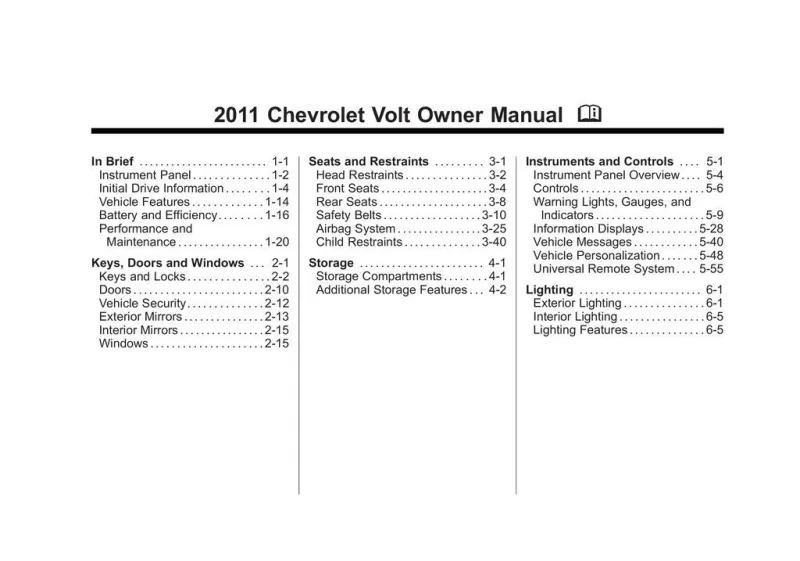2011 Chevrolet Volt Owner's Manual

Table of Contents
2011 Chevrolet Volt Overview
Introduction
The 2011 Chevrolet Volt is a groundbreaking electric vehicle that combines cutting-edge technology with the comfort and practicality of a traditional car. As a plug-in hybrid, it offers an impressive range, allowing drivers to tackle longer journeys without the common range anxiety associated with pure electric vehicles. Featuring a stylish design and a host of innovative features, the Volt is an ideal option for eco-conscious drivers looking to reduce their carbon footprint while enjoying a premium driving experience.
Powertrains
Under the hood, the 2011 Chevrolet Volt is powered by an advanced Voltec electric propulsion system that consists of a 149-horsepower electric motor and a 1.4-liter gasoline generator. The car can travel up to an estimated 35 miles on electric power alone, after which the gasoline generator seamlessly kicks in, extending the total range to around 375 miles. With a full charge taking just about 4 hours on a standard 120-volt outlet, the Volt balances impressive efficiency with convenience.
Trims
The 2011 Volt is available in two trims: the base model and the premium model. The base model offers a well-rounded set of features, including keyless entry, a six-speaker audio system, and a 7-inch touchscreen display. The premium model elevates the experience with extras like leather upholstery, a premium sound system, and enhanced navigation capabilities, making it a perfect choice for drivers seeking luxury and functionality.
Features
Packed with technological innovations, the Volt boasts an array of features designed for comfort and connectivity. The car includes Bluetooth connectivity, smartphone integration, and a sophisticated energy management system that allows drivers to monitor their electric usage. Additionally, its five-door hatchback layout provides ample cargo space, making it as practical as it is stylish.
Owner's Manual
The owner's manual for the 2011 Chevrolet Volt serves as an indispensable resource, detailing everything from basic operations to advanced navigation tips and maintenance schedules. It guides Volt owners through the unique aspects of the hybrid powertrain, ensuring they make the most of their driving experience while maximizing fuel efficiency and longevity of their vehicle.
User manual download
The Chevrolet Volt owner manual for the 2011 model year is to be found in PDF downloadable format on this page. The owner manual for the model year 2011 is free and in English, but the repair manuals are usually not easy to get and may cost more.
Manual Questions
Fill the form below and someone will help you!

